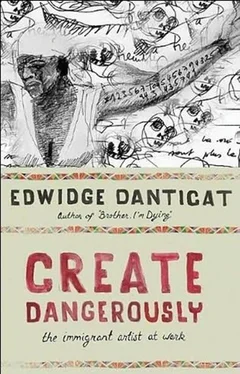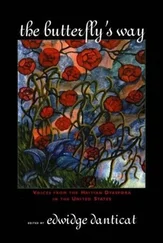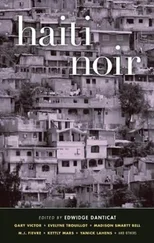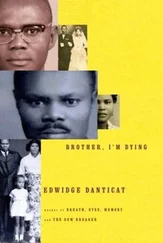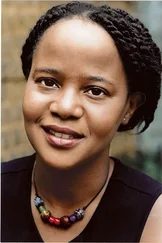“You should have told me about the coffee,” my father says, while reaching over and rescuing Ezekiel from my tight grasp. “We sure need that coffee now.”
We certainly could have used it that day, Tante Ilyana’s magic elixir, to help us remember and forget.
After managing to hold Ezekiel still for a while, my father puts him back on the floor. Ezekiel runs from us and immediately returns to the TV set, which he turns on again with glee. He stands there and stares in awe at the eye-level faces on the screen, and then trots over to touch them. He seems heartbroken to discover that the people are flat and cannot respond to him. Then he steps back and walks back to my father, grabbing his knee and burying his face in his pant leg.
As my father strokes young Ezekiel’s head, consoling his brief frustration, I realize that my way of saying good-bye, at least to Tante Ilyana, would never again be the same. I could no longer pretend that later in the day, or the next day, or even the following year I would ever see her or hear her call me a jounalis again.
I Am Not a Journalist
I began writing this essay on Monday, April 3, 2000, the morning that one of Haiti’s most famous journalists, the radio commentator Jean Dominique, was assassinated. That morning, I awakened to a series of alarming phone calls, the first simply reporting a rumor that Jean might have been shot while arriving at his radio station, Radio Haiti Inter, at six-thirty that morning for the daily news and editorial program he coanchored with his wife, Michèle Montas. The next few callers declared for certain that Jean had been shot: seven bullets in the head, neck, and chest. The final morning calls finally confirmed that Jean was dead.
The following hours would slip by in a haze as I went to teach my classes at the University of Miami, where I was a visiting professor that spring. When I came back to my office that afternoon, there were still more phone calls and e-mails from relatives, friends, and acquaintances, who could not believe what had happened. In those real and virtual conversations, the phrase that emerged most often was “Not Jean Do!”
During the varying lengths of time that many of us had known Jean Dominique-either as a voice on Haitian radio or in person-we had all come to think of him as heroically invincible. After all, he had survived the Duvalier dictatorship, during which his older brother Philippe had been murdered while participating in yet another failed invasion attempt to topple François Duvalier by taking over the military barracks across the street from Duvalier’s residence at the national palace.
Unlike his brother, Jean had survived several arrests and their resulting exiles, and had lived to return to Haiti to open and reopen his radio station, where being the owner and director allowed him a kind of autonomy that few hired journalists could manage in a volatile political climate. Jean had expressed his opinions freely, seemingly without fear, criticizing groups as well as individuals, organizations, and institutions who’d proven themselves to be inhumane, unethical, or simply unjust. Of course, Jean’s life was too multifaceted and complex to fully grasp and make sense of in these very early hours so soon after his death. What seemed undeniably compelling and memorable about him at that moment was his exceptional passion for Haiti and how that passion had finally betrayed him.
I couldn’t sort out fully, under this full assault of memories, the exact moment when I had met Jean Dominique. As a child in Haiti, I had heard his voice on the radio many times, sometimes blaring from ours or neighboring houses at the highest possible volume. As an adult in New York, I had seen him at so many different Haiti-related gatherings that I can’t even pinpoint our first in-person meeting. I do, however, remember the first time we had a lengthy conversation. It was at an art exhibit at Ramapo College in 1994. The exhibit was curated by our mutual friend, the filmmaker Jonathan Demme, and featured three emerging Haitian artists. The night of the exhibit, Jean was in exile yet again, after some U.S.-trained colonels leading the Haitian military had deposed President Jean-Bertrand Aristide and had raided and destroyed Jean’s radio station. The night of the art exhibit, Jean and I talked at length about the strikingly colorful paintings on display and the extreme nostalgia that they evoked in him, the hunger to return to his home and his radio station in Haiti as soon as he could.
A few weeks later, Jonathan Demme asked Jean and me to work with him on a project about the history of Haitian cinema. Every week, the three of us would meet on the Ramapo College campus to discuss Haitian cinema while some communications students watched and videotaped us. I said very little at those sessions, feeling rather shy sitting between two obsessive cinephiles. My job was to find prints of the films that we could discuss. Jean’s was to help us all understand them by putting them in context as Jonathan questioned him about technique, content, and style.
During the dictatorship, in the early 1960s, a young Jean had created a cinema club, hosting weekly screenings at the Alliance Française in Port-au-Prince. There he showed films such as Federico Fellini’s La Strada , which is, among other things, about a girl’s near enslavement as a circus performer.
“If you see a good film correctly,” Jean said, “the grammar of that film is a political act. Every time you see Fellini’s La Strada , even if there is no question of fascism, of political persecution, you feel something against the black part of life.”
Another favorite of his was the Alain Resnais documentary Night and Fog , which describes the horrors of concentration camps. “To us, Auschwitz was Fort Dimanche,” he said, referring to the Duvalier-era dungeonlike prison where thousands of Haitians were tortured and killed.
In 1964, the year Marcel Numa and Louis Drouin were executed, the Ciné Club was shut down by the Haitian military after a screening of Night and Fog at the Alliance Française. Jean then briefly turned to filmmaking, codirecting and narrating a short tongue-in-cheek documentary, Mais je suis belle (But I Am Beautiful), about a Haitian beauty pageant. This was, it is said, one of the first films made by Haitians in Haiti.
The task of finding the prints for the Haitian films being discussed in our Ramapo History of Haitian Cinema class proved herculean, as many of the filmmakers, including Jean, had lost track of their own prints during nomadic lives in exile. In our videotaped sessions, however, each time we’d mention a film title to Jean, he would proceed to describe at length not only the plot of the film but also extensive details of the method of its distribution and the political framework surrounding it. The film Anita , for example, made by Jean’s contemporary Rassoul Labuchin, told the story of a servant girl who is abused by the city relative to whom she’d been given by her peasant parents.
According to Labuchin, during the Ciné Club days, Jean had held conferences for aspiring filmmakers, encouraging them to view the seventh art as being essential to the majority of Haitians, particularly those who could not read. The most recent studies suggest that only about 56 percent of Haitians are literate. The actual figure is probably lower than that if one defines literate as, for example, being able to read an entire book. Perhaps this is why the visual arts have flourished in Haiti. Painters do not necessarily need to know how to read or write. This is what Jean had hoped filmmakers would do with film-make it, like radio and painting, a medium that would be not only open and available but also welcoming to those who were shut off from other means of information communication and entertainment. “Jean asked us to develop screenplays,” Labuchin would later say, “that meant something to the Haitian people.”
Читать дальше
